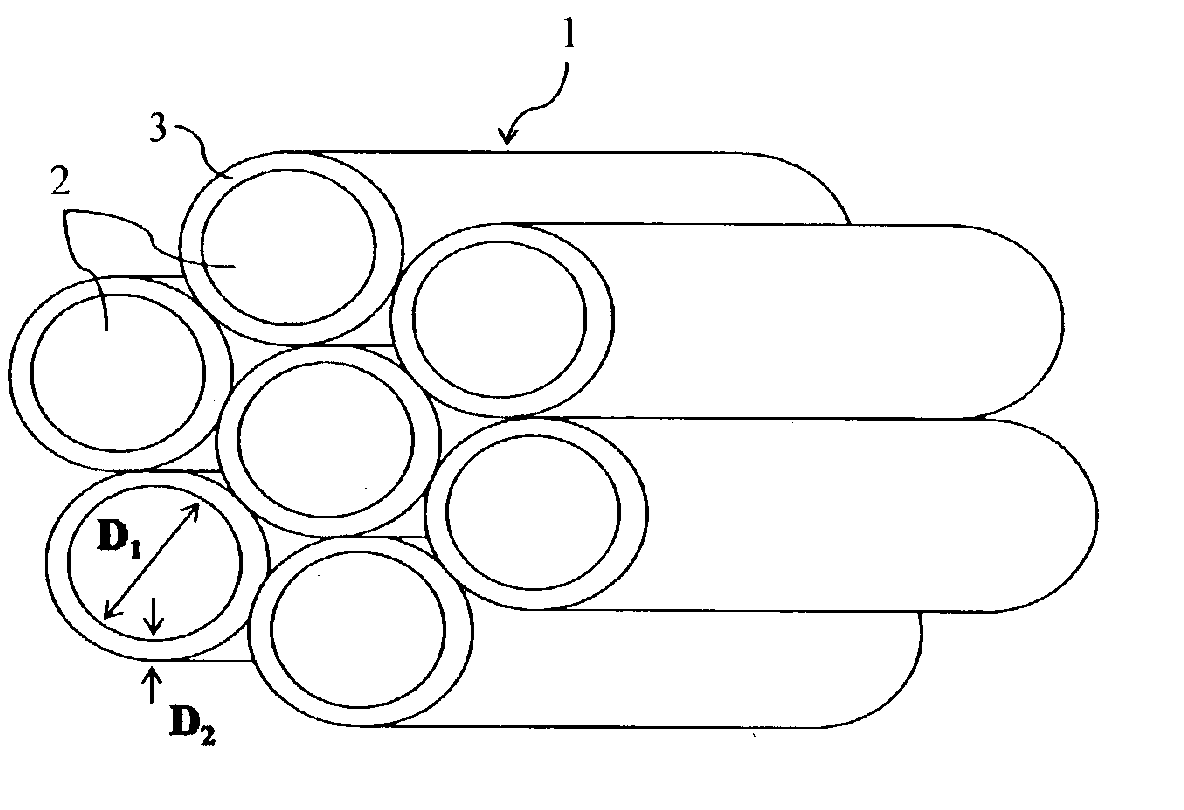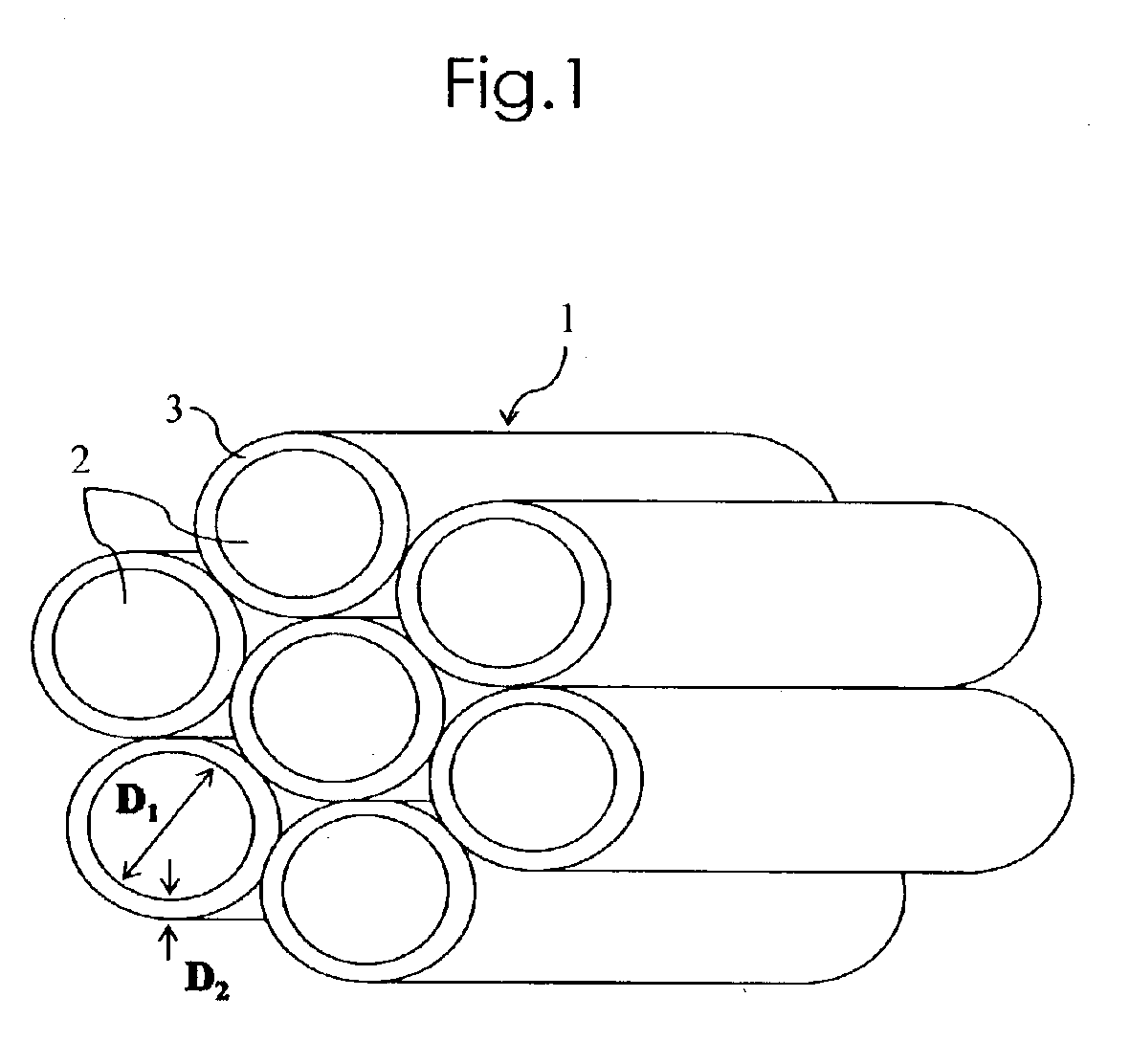Composite construction and manufacturing method thereof
a technology of composite materials and manufacturing methods, applied in the field of composite materials, can solve the problems of large residual stress between the core material and the shell layer, formation of voids, and the need to decompose and volatilize a large amount of organic binder, and achieve excellent strength, hardness and toughness
- Summary
- Abstract
- Description
- Claims
- Application Information
AI Technical Summary
Benefits of technology
Problems solved by technology
Method used
Image
Examples
example 1
[0081]To a mixture of 75% by weight of WC powder having an average particle diameter of 1.5 μm, 10% by weight of Co powder having an average particle diameter of 1 μm, 5% by weight of TiC powder having an average particle diameter of 2 μm, and 10% by weight of metal W powder having an average particle diameter of 1 μm, cellulose and polystyrene glycol as organic binder, and polyvinyl alcohol as solvent were added in the total amount of 100 parts by volume. This mixture was then kneaded and extruded in a cylindrical shape, thereby obtaining a core material molding.
[0082]On the other hand, to a mixture of 50% by weight of TiCN powder having an average particle diameter of 1.5 μm, 10% by weight of TiC powder having an average particle diameter of 1.5 μm, 7% by weight of Co powder having an, average particle diameter of 1 μm, 20% by weight of WC powder having an average particle diameter of 1.5 μm, 7% by weight of Mo2C powder having an average particle diameter of 2 μm, and 6% by weight...
example 2
[0089]A composite construction was manufactured in the same manner as Example 1, except that the material for shell layer in Example 1 was changed to a mixture of 80% by weight of WC powder having an average particle diameter of 0.2 μm, 8% by weight of Co powder having an average particle diameter of 0.5 μm, 0.3% by weight of VC powder having an average particle diameter of 0.8 μm, 0.7% by weight of Cr3C2 powder having an average particle diameter of 0.8 μm, and 11% by weight of metal W powder having an average particle diameter of 0.3 μm. The same evaluation was conducted and the following results were obtained. The residual free carbon amount Cin in the core material was 0.38% by weight, the residual free carbon amount Cout in the shell layer was 0.30% by weight, and the ratio Cin / Cout was 1.3. By measuring the residual stress in the interface between the core material and shell layer by X-ray diffraction, it was found that tensile stress of 43 MPa was present. The three-point ben...
example 3
[0090]A composite construction was manufactured in the same manner as Example 1, except that (i) the material for core material in Example 1 was changed to a mixture of 50% by weight of silicon carbide powder having an average particle diameter of 2 μm, 23% by weight of aluminum nitride powder having an average particle diameter of 2 μm, 17% by weight of alumina powder, and 10% by weight of metal silicon powder, (ii) the material for shell layer in Example 1 was changed to a mixture of 97% by weight of Si3N4 powder having an average particle diameter of 2 μm, 2% by weight of Y2O3 powder having an average particle diameter of 1.5 μm, and 1% by weight of Al2O3 powder having an average particle diameter of 1 μm, and (iii) the temperature at which the construction was sintered was changed to 1900° C. The same evaluation was conducted and the following results were obtained. The residual free carbon amount Cin in the core material was 0.20% by weight, the residual free carbon amount Cout...
PUM
| Property | Measurement | Unit |
|---|---|---|
| tensile stress | aaaaa | aaaaa |
| particle diameter | aaaaa | aaaaa |
| particle diameter | aaaaa | aaaaa |
Abstract
Description
Claims
Application Information
 Login to View More
Login to View More - R&D
- Intellectual Property
- Life Sciences
- Materials
- Tech Scout
- Unparalleled Data Quality
- Higher Quality Content
- 60% Fewer Hallucinations
Browse by: Latest US Patents, China's latest patents, Technical Efficacy Thesaurus, Application Domain, Technology Topic, Popular Technical Reports.
© 2025 PatSnap. All rights reserved.Legal|Privacy policy|Modern Slavery Act Transparency Statement|Sitemap|About US| Contact US: help@patsnap.com



